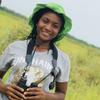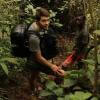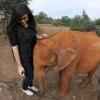Human-wildlife conflict and coexistence is a shockingly common problem, often with enormous consequences for both individual animals and entire populations.
When human-wildlife conflict comes to mind, you may immediately think of wildlife crime instead - which isn't wrong, since many regions with wildlife crime problems like poaching are also areas where people may frequently deal with human-wildlife conflict, causing the two issues to go hand-in-hand. But human-wildlife conflict is a much broader issue encompassing many ways that human presence and interference can cause problems for us and animals alike. Human-wildlife conflict includes:
- Elephants trampling a farmer's crops, resulting in retaliation
- New real estate developments infringing on ecosystems where predator species live, leading to predators having less territory and less food, which in turn leads to predators attacking domestic animals and livestock
- Freeways dividing the territory of animals like mountain lions, leading to wildlife venturing into neighborhoods or being killed by cars
- Lead bullets used in hunting causing scavengers like condors to die of lead poisoning
These are just a few examples of how humans can negatively impact wildlife, and it's clear to see how many of these scenarios could escalate. Human-wildlife conflict solutions don't just include ways in which we can prevent these issues (for example, through tracking predators, monitoring populations' territories, or building barriers and wildlife crossings monitored by sensors), but also the ways in which we can help people connect with wildlife and care about learning to live alongside them.
If you're interested in solutions that can prevent human-wildlife conflict, join this group and get to know the people who are working to protect and save species around the world!
Header image: Casey Allen on Unsplash
No showcases have been added to this group yet.
- @Rob_Appleby
- | He/him
Wild Spy
Whilst I love everything about WILDLABS and the conservation tech community I am mostly here for the badges!!





- 1 Resources
- 315 Discussions
- 11 Groups
- @Phil_HWS
- | Virtual Fencing
Innovations with Wildlife Fencing to mitigate Human Wildlife Conflict
- 0 Resources
- 4 Discussions
- 2 Groups
Royal Society for the Protection of Birds (RSPB)
- 0 Resources
- 0 Discussions
- 5 Groups
- @mimi_rezoana
- | She/her
I am Arefine from Bangladesh. I am a graduate student. I am a snake educator and young herpetologist. I founded Kundali Foundation for snake related work.
- 0 Resources
- 0 Discussions
- 9 Groups
- @a.zubiria
- | she/her
- 0 Resources
- 3 Discussions
- 11 Groups

- 0 Resources
- 0 Discussions
- 15 Groups
- @MorenaRodriguez
- | She/Her
- 0 Resources
- 1 Discussions
- 4 Groups
- @muganyizi
- | Mr.
Muganyizi Melchior Kamuganga is a Tanzanian youth passionate about creating positive social changes. He is a professional Wildlife manager and passionate beekeeper. He is a member of the Lightup impact community in east Africa, Masterpeace global network, Metis and Ashoka alumni
- 0 Resources
- 8 Discussions
- 8 Groups
conservation biologist working primarily in Argentina
- 0 Resources
- 1 Discussions
- 4 Groups
- @Yitmwa
- | She/Her
A conservation biologist with specialization in wildlife monitoring and community engagement. With experience in deploying camera traps and bioacoustics for mammal and birds monitoring in the Afrotropical environment.
- 0 Resources
- 1 Discussions
- 5 Groups
- @RobMCook
- | He
Ecologist specialising in human-wildlife conflict research. PhD in elephant ecology.

- 0 Resources
- 2 Discussions
- 4 Groups
- @Durgananda
- | He
- 0 Resources
- 0 Discussions
- 19 Groups
Wildlife Letters is announcing a call for papers on managing human-wildlife conflict in big cats
22 August 2024
Join us in celebrating this year’s Judging Panele Award winners!
19 August 2024
Join us in celebrating this year’s Community Choice Award winners!
15 August 2024
ADAP is looking for a post-graduate Tanzanain that has just finished her/his studies and would like to gain experience by conducting a study on human-wildlife conflicts
8 August 2024
WILDLABS is partnering with FLIR to give away a FLIR ONE Edge Pro to 5 community members.
26 June 2024
Traditional log bomas, used to protect livestock, are being replaced by more resilient wire fences. Wire fences offer several advantages: they are more durable, and provide better security against predators. This...
15 June 2024
Wildlife Drones was deployed by Zoos Victoria in a trial project tracking captive-bred Eastern Barred Bandicoots that were tagged and released into the wild
14 June 2024
WildLabs will soon launch a 'Funding and Finance' group. What would be your wish list for such a group? Would you be interested in co-managing or otherwise helping out?
5 June 2024
Now accepting applications for two $15,000 grants to help protect wildlife through cutting-edge, technology-driven efforts
3 June 2024
The IEF's Elephant Conservation and Research Funding Support Program has opened a call for applications. Average grant size is $15K, whereas the IEF funds 20 to 25 projects per year.
22 May 2024
Do you have photos and videos of your conservation tech work? We want to include them in a conservation technology showcase video
17 May 2024
Article
Read in detail about how to use The Inventory, our new living directory of conservation technology tools, organisations, and R&D projects.
1 May 2024
October 2025
event
October 2024
September 2024
event
32 Products
3 R&D Projects
42 Organisations
Recently updated products
Recently updated R&D Projects
Recently updated organisations
| Description | Activity | Replies | Groups | Updated |
|---|---|---|---|---|
| Dear Femke, Thank you for your email. I hope I can hear from Mohan Raj. Electric fencing is one area where it can play very important role in human wildlife conflict management... |
|
Human-Wildlife Coexistence | 6 years 7 months ago | |
| Dear all, We wanted to share an interesting article we came across some time ago. It is about human-wildlife conflicts in Botswana, and... |
|
Human-Wildlife Coexistence | 6 years 7 months ago | |
| Hi all, I just came accross this interesting website and call for proposals for the use of Artificial Intelligence to help address... |
|
Human-Wildlife Coexistence | 6 years 9 months ago | |
| Hi Nilanga, Thanks for introducing me here and I'm looking forward to some interesting discussions with everyone here! Femke |
|
Human-Wildlife Coexistence | 6 years 9 months ago | |
| Hello Fleury I am aware that such a collar has been tested in France to protect sheeps fromm wolves' attacks. I am also looking for some information about it to... |
|
Human-Wildlife Coexistence | 6 years 9 months ago | |
| Hi Anne and the Arribada team. This is such an exciting project and so pleased to see the progress you are making. A couple of quick ideas sprang to mind reading your... |
|
Human-Wildlife Coexistence | 6 years 11 months ago | |
| Here's a blurb of our idea cut-and-pasted from our application: We propose utilising animal detection and alerting technology that Wild Spy has already developed and... |
+7
|
Human-Wildlife Coexistence | 6 years 11 months ago | |
| Does anyone remember the 11-year-old Masaai boy who invented 'Lion Lights' as a solution to stop lions from killing his livestock?... |
|
Human-Wildlife Coexistence | 7 years ago | |
| Call for Papers: Challenges and solutions to human-wildlife conflict in agricultural landscapes SCB journal... |
|
Human-Wildlife Coexistence | 7 years ago | |
| Our new mobile app, "i of the Elephant", is beginning to pay off. Acting on a report from our app, last month agents from the New York State Department of... |
|
Human-Wildlife Coexistence | 7 years ago | |
| The IUCN HWC task force has launched a new online document library. In the library, you will find some key literature on many human-... |
|
Human-Wildlife Coexistence | 7 years 1 month ago | |
| I second Nilanga's words -- inspiring and valuable experience and innovative results from this event. It was an amazing opportunity to meet and network with a group of... |
|
Human-Wildlife Coexistence | 7 years 5 months ago |
Helping humans and tigers to co-exist in India
30 November 2020 7:08pm
Predator Deterrent - Human Effigy Based
3 October 2020 2:15am
Audio play back device when elephant crop raids
7 November 2019 7:55am
27 September 2020 1:57am
Suraci et al. have published a few papers about the use of an automated behavioral response system for sound playback when triggered by a camera trap. Their methods (see supplementary materials) are entirely open source and I even commissioned an engineer to make a few for me. The only issue is that the MP3 players need a separate battery pack to keep them charged or need to be charged weekly, as the sound runs continuosly since there would otherwise be a delay between the camera trigger and the MP3 player being turned on. This could probably be fiddled with to suit your needs, if the previous options don't work out.
https://besjournals.onlinelibrary.wiley.com/doi/10.1111/2041-210X.12711
27 September 2020 3:31am
We actually designed Boombox, the audio player shown above, based on the ABRS system by the Suraci paper and with Dr. Meredith Palmer. We made some optimizations on it since the paper advocates an approach to infer when the camera was triggered. We reverse engineered our camera traps and took the actual trigger signal from the trailcam PIR motion sensor. Later, we were contacted by one of the authors of the paper and he mentioned they had come to the same conclusion.
We built the MP3 playback system using a discrete MP3 decoder IC which allowed us more control over playback, power management, and we could pick out the output amplifier to drive the speakers. We knew we would need to put the system to sleep and immediately play sounds on wakeup which most players aren't suited to do.
We also made it so that it's solar rechargeable with lithium-ion batteries so that it could last in the field as long as possible. Unfortunately we couldn't use that feature because there's no point in outlasting the trailcams. But for this application, it seems we might be able to use the solar recharging functionality.
We've volunteered for a possible TechTutors season 2 workshop on open source MP3 playback and recording with Arduino. We're waiting to discuss it with Steph and Ellie. If this sounds interesting, please let us know.
Challenge: ElephantEdge
11 August 2020 12:00am
Did you know that Wildtrack's Footprint Identification Technique (FIT) can be used to promote human-wildlife coexistence!
3 June 2020 6:47pm
18 June 2020 4:38am
Hi Santhosh, welcome to the FIT community, we're glad you joined!
Karin has explained very nicely the difference between the footprint identification technique (FIT) that we use and the old 'pugmark' technique. I'd say that every technique, FIT included, has strengths and weaknesses. FIT, for example, will not work in an area where footprints can't be found. The pugmark technique was very reliant on expert assessment and was prone to inaccuracies for that reason, but on the plus side it could be rolled out over a huge area and engaged the traditional ecological knowledge that is part of India's cultural heritage. The camera traps that replaced it have had their fair share of problems (difficulties arranging the traps for optimal sampling, cameras being stolen, cameras are expensive etc). Our belief is that using several different non-invasive techniques for any one survey yields the most reliable results. I hope this helps.
18 June 2020 9:17pm
Thank you Karin for these details, I didnt read the latest papers, before writing my comment. Interesting to know about morphometrics usage (along with image processing).
18 June 2020 9:21pm
Thank you for these details.
I was about to ask the issues with different substrates. Now I understand the limitations and possibilities.
Yeah, I agree that each of these techniques have their own limitations. Thank you, these inputs definitely help.
Grassroots Innovations for Wildlife Conservation
19 May 2020 12:00am
Get To Know FIT
6 May 2020 12:00am
Era of the Condor: A Species' Future in Recovery
5 May 2020 12:00am
Locally-Brewed Conservation Technology from a Small Town in North Bengal
10 April 2020 12:00am
Technology Showroom of Artificial Intelligence (AI) aided Elephant Early Warning Systems
6 March 2020 6:09pm
19 March 2020 9:15am
Hi @Tim+Vedanayagam
Thank you for posting this. I'd be happy to contribute to the thermal sensing work under way. Can you confirm - have you built a thermal AI model and trained / labelled data for a particular camera?
We have been training a model for low cost (Lepton 3.5) thermal cameras via a challenge with WWF / Wildlabs and have 30,000 labelled images as our training dataset of Asian elephants. We're focusing on Deeplabel and YOLO with a plan to port to Tensorflow and it will be open source, so applicable for others to use and adopt in their early warning systems that use thermal.
More info here - https://www.zsl.org/blogs/conservation/zsl-whipsnade-zoo-becomes-a-space-for-high-tech-wild-elephant-conservation
Kind regards,
Alasdair
Webinar: IIED Community-Based Approaches to Tackling Poaching and Illegal Wildlife Trade
 IIED
IIED
17 March 2020 12:00am
Testing an Early Warning System to Mitigate Human-Wildlife Conflict on the Bhutan-India Border
11 March 2020 12:00am
3 Ways Your Conservation Technology Could Become a Shiny Pile of Junk, and How to Avoid It
9 March 2020 12:00am
#Tech4Wildlife 2020 Photo Challenge In Review
4 March 2020 12:00am
Accepting Applications: ArcGIS Solutions for Protected Area Management
4 March 2020 12:00am
Call for Nominations: Tusk Conservation Awards
3 March 2020 12:00am
Fence-Based Elephant Early Warning System
25 February 2020 12:00am
HWC Tech Challenge Update: Thermal Elephant Alert System
17 February 2020 12:00am
A New Cloud Platform Unveils the Most Diverse Camera Trap Database in the World
17 December 2019 12:00am
Mitigate Elephant-Human Conflict with ADSMO
[ARCHIVED] Upcoming Event: International Conference on Human-Wildlife Conflict and Coexistence
4 November 2019 10:54am
AI powered mobile app to save snakes
4 October 2019 7:10am
9 October 2019 8:45pm
Hi Nilaksha,
Interesting idea. My ideas are usually not that helpful, but I thought I would chime in with the following:
(1) Start small and local, this will help reduce the size of the training data set you will need. So if you can work with a specific set of communities in a particular area that has a known set of snake species, both venemous and non-venemous, you only need images for those species and you won't need as many.
(2) iNaturalist has a pretty decent database (not thousands, but hundreds) of identified images. I have no idea what the restrictions would be around getting access to the database, but this is a Citizen Science organization, so I don't THINK it should be too complicated, especially if your initial scope is limited.
(3) Venemous snakes need "love" too. PLEASE make sure the app does not encourage the locals to kill the venemous snakes unless absolutely necessary. While it is admirable to prevent the accidental killing of a non-venemous snake, you shoudl not be encouraging the purposeful killing of the venemous snakes, but should be encouraging people to stay clear if the snake is in the wild and get professional assistance if the snake somewhere that could be dangerous to humans or other animals.
(4) Look into organizations like the Rainforest Aliance, OpenAI, etc., which are non-profits doing work in or with AI, they might be able to help give you a leg up.
(5) If you start local, you could build into the app the contact information for the professionals to come in and deal with the dangerous snakes.
Hopefully some of this is useful.
Good luck,
Drue
10 October 2019 1:57pm
Thanks Drue for your valuable input.
This is certainly not to encourage killing venomouse snakes. We can actually incorporate the featurs you pointed out to save venomouse snakes as well. Ideally we can let the user know how to deal with a venomouse snake and whome to contact if he/she needs professional assistance.
Thanks again.
Nilaksha
Trade of body parts
23 August 2019 12:16am
Tech In the Wild: Where technology meets conservation
 Fauna & Flora
Fauna & Flora
22 August 2019 12:00am
Conservation and Technology Conference
 Bat Conservation Trust
Bat Conservation Trust
29 July 2019 12:00am
New technology trialled to better monitor human-gorilla conflict in Uganda
23 July 2019 12:00am
Makerspaces to empower communities to develop/refine their own solutions to HEC
27 May 2019 8:27am
28 May 2019 11:37pm
3 June 2019 3:31pm
Hi Aditya,
If you haven't already found it, you should check out our last virtual meetup, it was all about tools and spaces for collaboration and we featured a number of members who have set up and are working on conservation focused makerspaces. You can watch in and connect to the members featured here.
Steph
Caught in the crossfire – Tapirs in tiger territory
31 May 2019 12:00am
Technology lab focused on wildlife protection opens on Ol Pejeta Conservancy
31 May 2019 12:00am
HWC Tech Challenge: Smart Parks field update
25 March 2019 12:00am






















































23 September 2020 7:27am
I've worked on a similar project to try to scare lions away from bomas in Kenya that's pretty much a bunch of stuff from Adafruit rigged together with cheap marine speakers in an overly complicated custom case (picture is of previous generation, new generation in development). We also run LEDs to show various light displays. I imagine you could imitate a muzzle flash to deepen the illusion of gunfire. I'm also happy to discuss things (although I don't think I can match the technical expertise of Freaklabs).